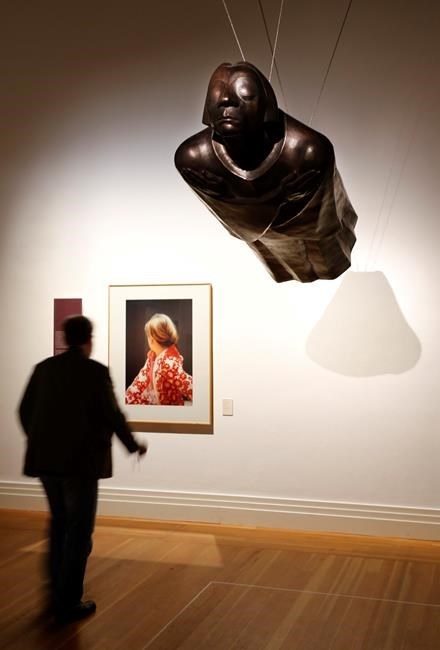
A man looks at the work 'Betty' by Gerhard Richter underneath the sculpture 'The Hovering' by Ernst Barlach during a press preview for the exhibition 'The British view' in the Gropius-Bau in Berlin, Germany, Friday, Oct. 7, 2016. The exhibition 'The British View: Germany – Memories of a Nation' runs through Jan. 9, 2017. (AP Photo/Ferdinand Ostrop)
October 07, 2016 - 6:06 AM
BERLIN - The British Museum is serving Germans a view from London of centuries of their own history.
Some 200 exhibits illustrating the complex political and cultural history of Germany, which didn't unify as a nation until the late 19th century, have been brought together at Berlin's Martin-Gropius-Bau museum for the show.
They include a huge 16th-century print commissioned from Albrecht Duerer's workshop by the Holy Roman Emperor Maximilian I to celebrate his achievements; a replica of the entrance gate to the Nazis' Buchenwald concentration camp; elaborate 17th-century drinking vessels; an early Benz car; a 1952 Volkswagen Beetle; and a homemade pro-reunification placard in the shape of the country from a 1989 East Berlin demonstration, declaring that "We are one people."
The show, "The British View: Germany — Memories of a Nation," is based on an exhibition that opened in London two years ago and was originally designed to show Britons more about a neighbour whose pre-20th century history they are generally unfamiliar with.
"Our German colleagues asked for the exhibition to come to Berlin, and I shall be very interested to see how a German public responds to an exhibition which was designed for foreigners," said former British Museum director Neil MacGregor.
"Much of what we are showing here — things like the political fragmentation of Germany, the habit of many different states, the habit of sharing power or not having one dominant capital — these are very strange things to a British or a French person," said MacGregor, who has been tapped to lead a new cultural history museum in Berlin.
The exhibition illustrates that difference by showing coins from the many currencies of German states around 1700, when Britain had only one currency. And it highlights Germany's history of fluid borders, with a section titled "German no more" featuring places such as Strasbourg and Koenigsberg — now the Russian city of Kaliningrad — that at various points ceased to be part of the German-speaking world.
MacGregor acknowledged that German history is, for most people, dominated by the events of the 20th century. But he said "what we wanted to do is to put that story into a longer perspective."
The exhibition includes works that illustrate the complexity of Germans' relationship with their own history — such as a cast of the 1927 sculpture "The Floater" by Ernst Barlach, who returned from World War I a pacifist.
The angel-like figure, suspended from the ceiling, illustrates the grief of war. Much of Barlach's work was confiscated as "degenerate art" under Nazi rule. An original cast was melted down in 1937, and copies were shown in both East and West Germany after World War II.
The British exhibition "opens up for us the view into the past and gives us back our own history, a journey that is astounding, rich and complex and shown in a very English way — very light, very confident," said Thomas Oberender, artistic director of the organization that oversees the Martin-Gropius-Bau.
The show opens to the public Saturday and runs through Jan. 9.
___
Online:
Exhibition site: http://tinyurl.com/hzvyl8r
News from © The Associated Press, 2016